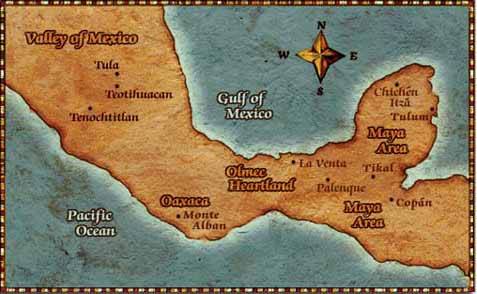
Olmec Civilization
1200 BC- 600 AD

The Olmecs were a culture of ancient peoples of the East Mexico lowlands. They are often regarded as the Mother Culture of later Middle American civilizations. The Olmec people called themselves Xi (pronounced Shi).
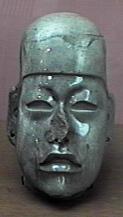
Portrait of a man. This life-sized greenstone head was found at Tenango del Valle, Mexico State, surprisingly a distance west from the Olmec heartland of Veracruz and Tabasco.
GEOGRAPHY
The Olmec domain extended from the Tuxtlas mountains in the west to the lowlands of the Chontalpa in the east, a region with significant variations in geology and ecology. Over 170 Olmec monuments have been found within the area, and eighty percent of those occur at the three largest Olmec centers, La Venta, Tabasco (38%), San Lorenzo Tenochtitlan, Veracruz (30%), and Laguna de los Cerros, Veracruz (12%).
Those three major Olmec centers are spaced from east to west across the domain so that each center could exploit, control, and provide a distinct set of natural resources valuable to the overall Olmec economy. La Venta, the eastern center, is near the rich estuaries of the coast, and also could have provided cacao, rubber, and salt. San Lorenzo, at the center of the Olmec domain, controlled the vast flood plain area of Coatzacoalcos basin and riverline trade routes. Laguna de los Cerros, adjacent to the Tuxtlas mountains, is positioned near important sources of basalt, a stone needed to manufacture manos, metates, and monuments. Perhaps marriage alliances between Olmec centers helped maintain such an exchange network.
CALENDARS - MATHEMATICS
The Olmecs were clever mathematicians and astronomers who made accurate calendars.
The epi-Olmec - from 31B.C. - the peoples who subsequently inhabited the same lands and were probably descended at least in part from the Olmec, seem to have been the earliest users of the bar and dot system of recording time.
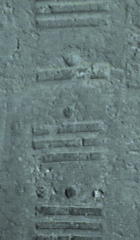
Detail of Long Count Date
The low relief on this stone shows the detail from a four-digit numerical recording, read as 15.6.16.18. The vigesimal (or base-20) counting system has been used across Mesoamerica. A value of 5 is represented by a bar, and a value of 1 is represented by a dot, such that the three bars and single dot here stands for 16. The Maya would later adopt this counting system for their Long Count calendar. The date in this relief is the oldest recorded date in Mesoamerica, corresponding to a day in the year 31 B.C.
WRITING
The Olmec writing is unique. Both the Olmec and epi-Olmec had hieroglyphic writing systems. Olmec is a syllabic writing system used in the Olmec heartland from 900 BC- AD 450. The Olmec had both a syllabic and hieroglyphic script. The hieroglyphic signs were simply Olmec syllabic signs used to make pictures. There are two forms of Olmec hieroglyphic writing : the pure hieroglyphics ( or picture signs); and the phonetic hieroglyphics, which are a combination of syllabic and logographic signs.
The decipherment of the Olmec writing of ancient Mexico provides us with keen insight into the world of the Olmec. Scholars have long recognized that the Olmecs engraved many sysmbols or signs on pottery, statuettes, batons/scepters, stelas and bas reliefs that have been recognized as a possible form of writing.
SOCIETY
Many early scholars were reluctant to believe that a society as sophisticated as the Olmec could have developed in the tropical habitat of the Gulf coast, and some hypothesized that the Olmec had originally migrated from elsewhere. However, recent excavations have provided valuable new information on the antiquity of those sites, and on Olmec ways of life at those centers. Their radiocarbon dates inform us that La Venta and San Lorenzo were inhabited as early as 1700 B.C., by peoples who were the direct ancestors to the Gulf coast. They were corn farmers who supplemented their diets with fishing and hunting. Linguists suggest that they spoke a language related to the Mixe and Zoque languages of today.
OLMEC CENTERS
The great Olmec centers that soon developed at La Venta, San Lorenzo, and Laguna de los Cerros, and the smaller centers such as Tres Zapotes, were not simply vacant religious sites, but dynamic settlements that included artisans and farmers, as well as religious specialists and the rulers. The Olmec architecture at San Lorenzo, for example, includes both public-ceremonial buildings, elite residences, and the houses of commoners. Olmec public-ceremonial buildings were most typically earthen platform mounds, some of which had larger house-like structures built upon them. At La Venta we can see that after 900 B.C. such platform mounds were arranged around large plaza areas and include a new type of architecture, a tall pyramid mound.
IRRIGATION - STONE DRAIN SYSTEMS
An important feature at Olmec centers was their buried network of stone drain lines - long U-shaped rectangular blocks of basalt laid end to end and covered with capstones. The new San Lorenzo research suggests those systems were actually aqueducts used to provide drinking water to the different areas of the settlement. Some of the aqueduct stones, such as San Lorenzo Monument 52, were also monuments, indicating that the aqueduct system had a sacred character as well.
BALL GAMES
Rubber ball games have great antiquity throughout the Americas, and the recent discovery of several rubber balls at the Olmec site of El Manati, near San Lorenzo, confirms that the game was played by the Olmec. Archaeologists working at La Venta twenty years ago discovered what they hypothesized were the remains of a ball court there, and it is possible that such ball courts were also part of the architecture at Olmec centers.
MONUMENTS - STONE HEADS
In 1862 a colossal stone head was discovered in the state of Veracruz along the steaming Gulf Coast of Mexico. In the years to come, artifacts from the culture later termed Olmec turned up at widespread sites in Mexico and adjacent Central America, with the greatest number of characteristic themes being present in the region of the original discovery.
Monuments were also an important characteristic of Olmec centers. Today they provide us with some idea of the nature of Olmec ideology. The colossal heads are commanding portraits of individual Olmec rulers, and the large symbol displayed on the 'helmet' of each colossal head appears to be an identification motif for that person.
Colossal heads glorified the rulers while they were alive, and commemorated them as revered ancestors after their death. Altars were actually the thrones of Olmec rulers. The carving on the front of the throne shows the identified ruler sitting in a niche that symbolizes a cave entrance to the supernatural powers of the underworld. That scene communicated to the people their ruler's association with cosmological power.
The magnificent colossal stone heads, massive altars, and sophisticated anthropomorphic and zoomorphic statues found at Olmec sites in southern Veracruz and Tabasco, are the oldest known monuments in Prehispanic Mexico.
In 1939 a carving was discovered near the gigantic head with a characteristic Olmec design on one side and a date symbol on the other. This revealed a shocking truth: the Olmecs had a far greater right to be considered the mother culture. Hundreds of years earlier than anyone had imagined, simple villages had given way to a complex society governed by kings and priests, with impressive ceremonial centers and artworks.
It is now known that two colossal stone heads from San Lorenzo had originally been large rectangular altars that were later resculpted into colossal heads. When a ruler died, he was venerated by converting his throne into his colossal portrait head.
Although archaeology has answered many questions about the Olmec, many more still remain. Research has concentrated primarily on the centers of San Lorenzo and La Venta, and very little is known about Laguna de los Cerros, or smaller Olmec centers, or Olmec life in small farming hamlets. We also have very little archaeological information about the 500-300 B.C. time period in southern Veracruz and Tabasco and, therefore, we do not know how the Olmec culture ended. San Lorenzo and La Venta declined in importance, perhaps due to major change in the river systems that helped support those centers. However, in the northern area of the Olmec domain there was some cultural continuity long after 500 B.C. Tres Zapotes became an important post-Olmec center, and Laguna de los Cerros continued as a major center into the Classic period.
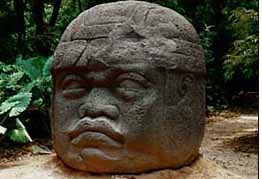
One of the huge Olmec sculptures found at La Venta - This head is approximately 6 feet tall and 5 feet across. The stone it was cut from was quarried more than 50 miles from where it was discovered, prompting speculation about how it was transported.
ART
The Olmecs made fine pottery and carved jade jewelery. They had early achievements in art. Perhaps the most incredible findings from the Olmec culture are the sculptures. The Olmec used wood, basalt and jade to make the statues. The wooden artifacts are said to be the oldest in Mesoamerica.
The Olmec used basalt to make colossal heads. The size of these heads ranged from 5 feet to 11 feet tall. Some say the heads represent sacrificial offering. Others think they portray the elite Olmec ancestors. These heads have also been interpreted as being warriors or ball players. Basalt was also used to carve thrones.
The Olmec used art to glorify rulers by making them monuments of super natural creatures to portray them such as part human, part beast. The beast was usually the jaguar. It is believed that these monuments were annihilated after the death of the leader. The figurines made of jade were small and sexless. Some of the more elaborate statues wore extensive headdress with a long train, and rectangular chest plates, sat cross-legged, leaned forward and looked straight ahead.
A characteristic motif of Olmec art is a human face with a jaguar mouth, sometimes called a "were-jaguar" (as in werewolf). This suggests a derivation of Olmec religion from shamanistic shape-shifting. There is evidence that the Olmecs practiced human sacrifice, including that of infants.
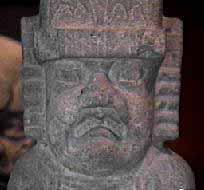
Jaguar Child
The most well-known aspect of shamanism in Mesoamerican religion - and in the whole of Native American shamanism - is the ability to assume the powers of animals associated with the shaman. Such animals are called nahuales, and in Olmec art the most common of these is the jaguar. In a sense, the optimal spirit would have the spirituality and intellect of man and the ferocity and strength of the jaguar - these are all combined in the shaman and his jaguar nahuale. The Jaguar Child may exemplify this combination. This is a very common representation in Olmec art, and it often includes the slitted eyes and curved mouth pronounced in this close-up.
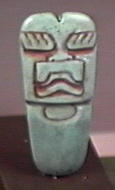
Eagle Spirit
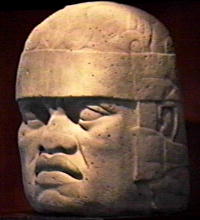
Monolithic Head
This is one of the many such heads made by the Olmecs. Almost all of these colossal heads bear the same features - flattened nose, wide lips, and capping headpiece - possible features of the Olmec warrior-kings. Often carved from volcanic stone at the stone's source, these heads would be rafted to the centers of the major Olmec cities along the southern Gulf of Mexico coast. Of the 9 heads catalogued from the ruins of San Lorenzo in southern Veracruz state, this is referred to as San Lorenzo 6.
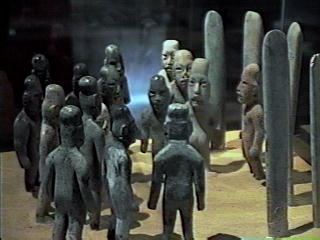
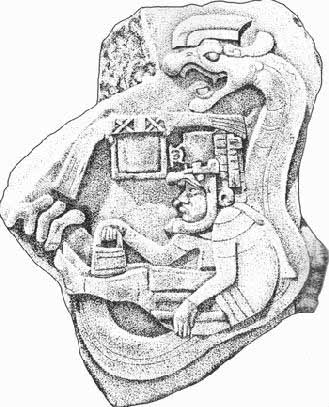
Serpent-Riding Shaman
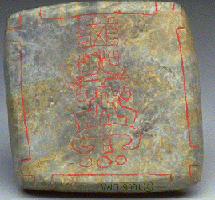
OLMEC GLYPH 900-500 BC: Dallas Museum
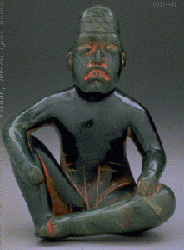
Olmec Ruler - or God - connected physical and spiritual worlds. His pose represents his means to link with the supernatural worlds. The turned down mouth, a feline feature, suggests that the human ruler was aided by a power anumal such as a cat, jacquar, traditionally the spirit campanion of shamans and kings.
GODS AND GODDESSES
JAGUAR GOD
Some people believe that the principal deity was fundamentally an Earth god, though his power was not limited to terrestrial matters, and took the form of a jaguar. This God could have a water-earth persona. As a jaguar encompassing the forces of life or at least a dominance in its two strongest categories (with regards to Olmec life), water and earth. This deity supposedly had dominance over all things terrestrial and celestial.
This God may have been half-jaguar, half-serpent. The jaguar represents the Earth Mother with the serpent representing the water, thus combining to represent life.
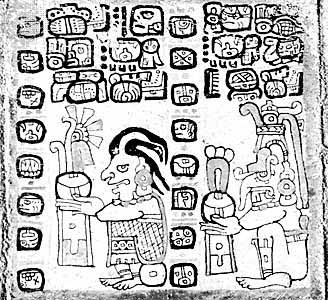
RAIN GOD
It was formerly thought that the Olmec worshiped only one god, a rain deity depicted as a were-jaguar, but study has shown that there were at least 10 distinct gods represented in Olmec art. Surely present were several important deities of the later, established Meso-American pantheon, such as the fire god, rain god, corn god, and Feathered Serpent. Other aspects of mental culture are less well-known; some Olmec jades and a monument from La Venta have non-calendrical hieroglyphs, but none of this writing has been deciphered.
The Olmecs are believed to be one of the first tribes to engage in Shamanistic rituals. In the Olmec civilization the reoccurring motif of the ŚWere-jaguarą can be seen in many statuettes and carvings. It is believed that the Olmecs were a kind of "mother culture" which directly gave rise to all subsequent major civilisations and this is how Shamanism first spread. The Olmecs are said to have been ancestors of the Jaquar. The Olmec Tribe believed that the Jaquar was a rain deity and fertility diety. The Jaquar was chosen because the Olmecs believed it was the most powerful and feared animal. They also believed that the Jaquar was an Avatar of the living and the dead.
The men would sacrifice blood to the jaguar, wear masks, dance, and crack whips to imitate the sound of thunder. This ritual was done in May. The Olmec also made offerings of jade figures to the jaguar.
The Olmecs made numerous statues representing "Were - Jaquar " men. These men are normally shown with grimacing Jaquar facial features with Human bodies. They are believed to be men , of the Olmec tribe, that are transforming into the Jaquar. One of these transforming Shamans can be seen in the statue "Crouching figure of a Man-Jaquar".
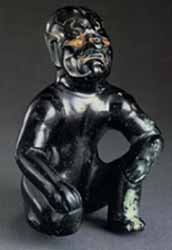
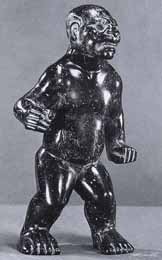
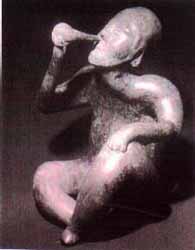
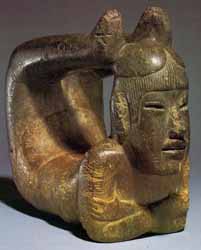
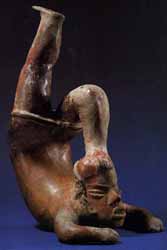
The Olmec had many beliefs. Among these beliefs were chaneques which were
dwarf trixters who lived in water falls. They also had their own beliefs in cosmology. The Olmec had natural shrines devoted to the hill on which the shrine was located and the water.
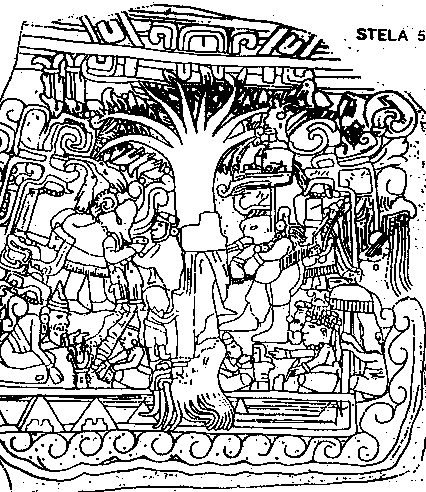
It is clear from this Stela from Izapa that the Olmec recognized the Tree of Life.
it confirms the tradition recorded by Friar Diego de Landa that the Olmec people made twelve migrations to the New World. This stela also confirms the tradition recorded by the famous Mayan historian Ixtlixochitl, that the Olmec came to Mexico in "ships of barks " and landed at Pontochan, which they commenced to populate (Winters 1984: 16). These Blacks are frequently depicted in the Mayan books/writings carrying trade goods.
The tree depicts seven branches and twelve roots. The seven branches probably represent the seven major clans of the Olmec people. The twelve roots of the tree extending into the water from the boat probably signifies the "twelve roads through the sea", mentioned by Friar Diego Landa.